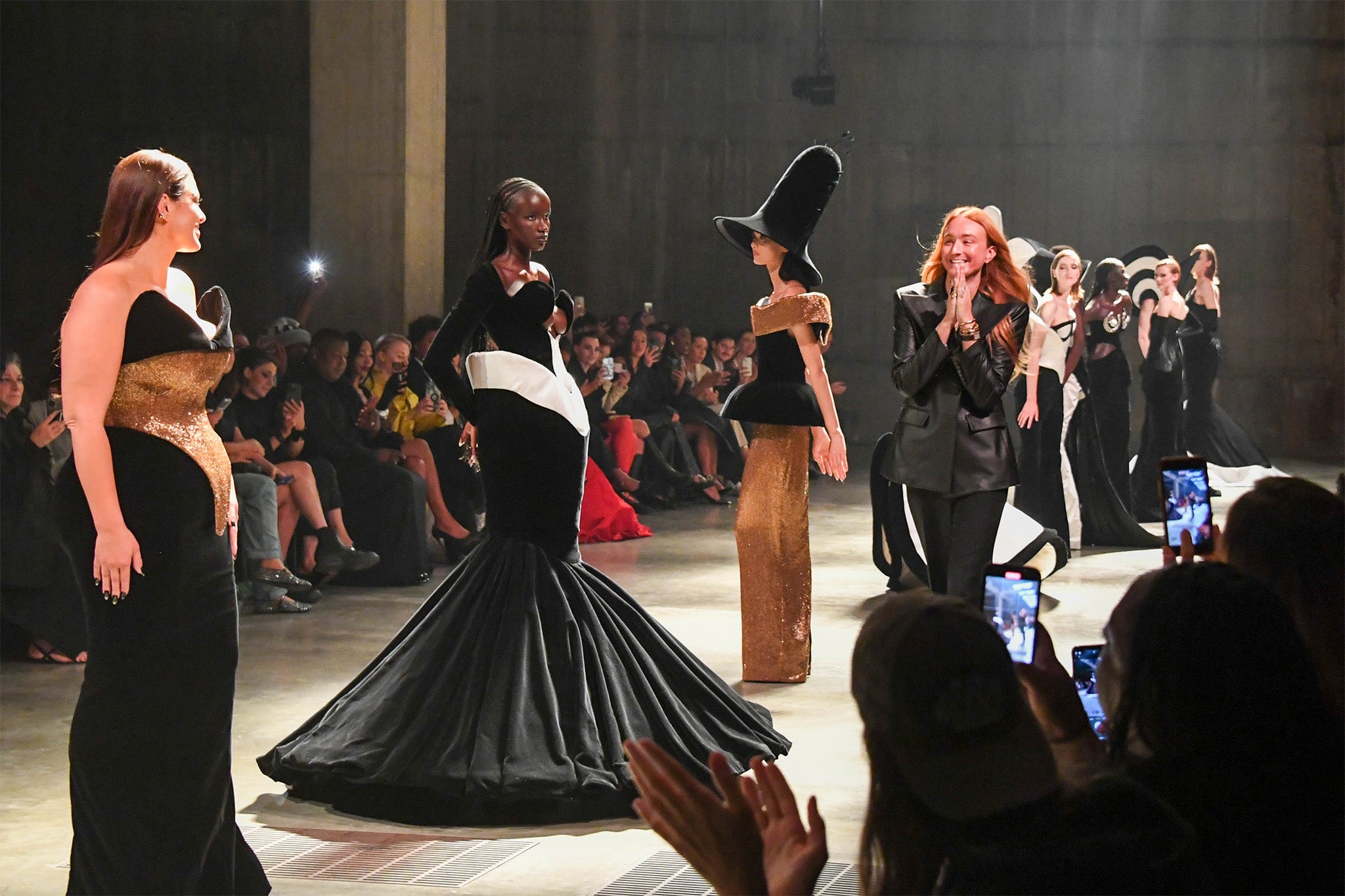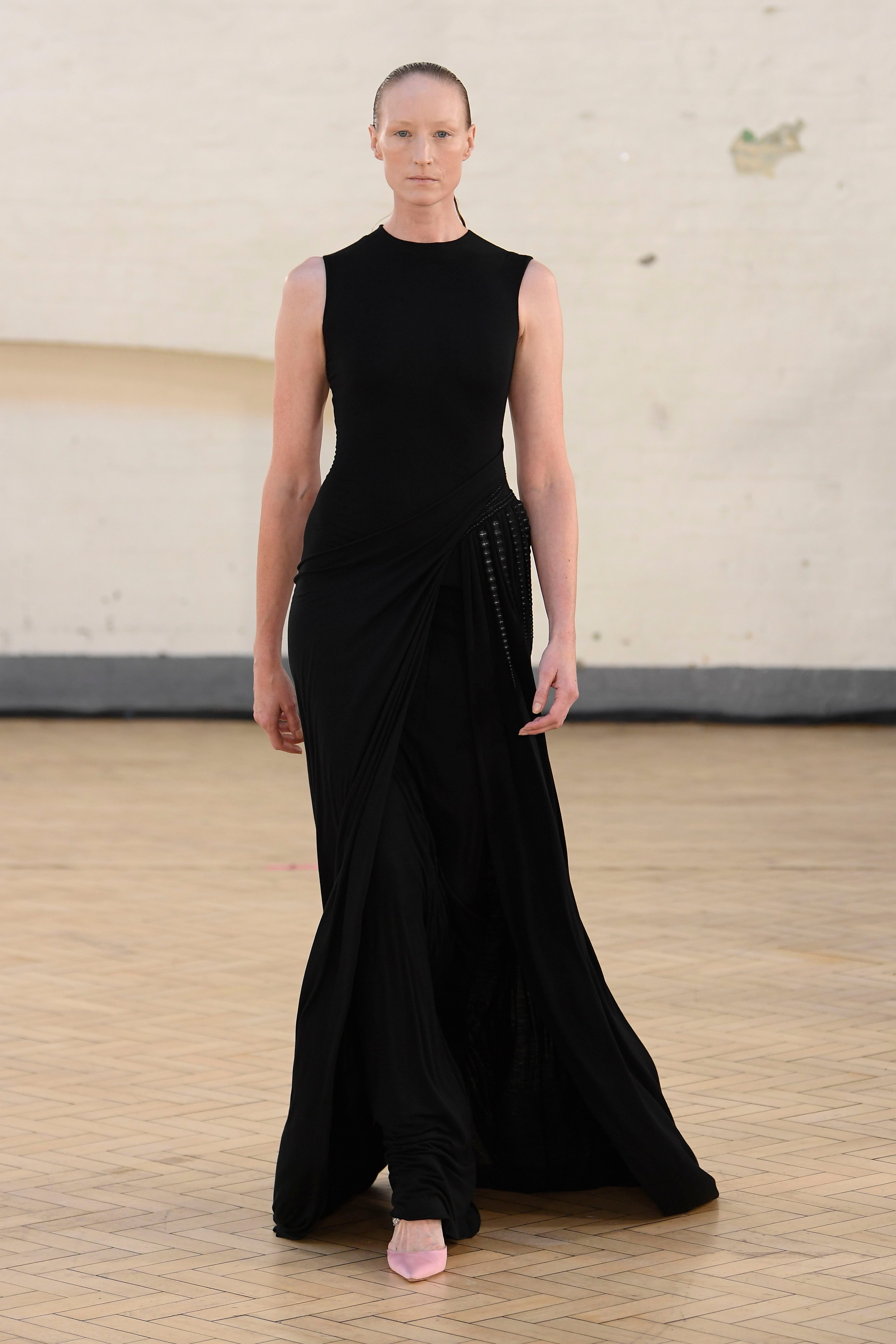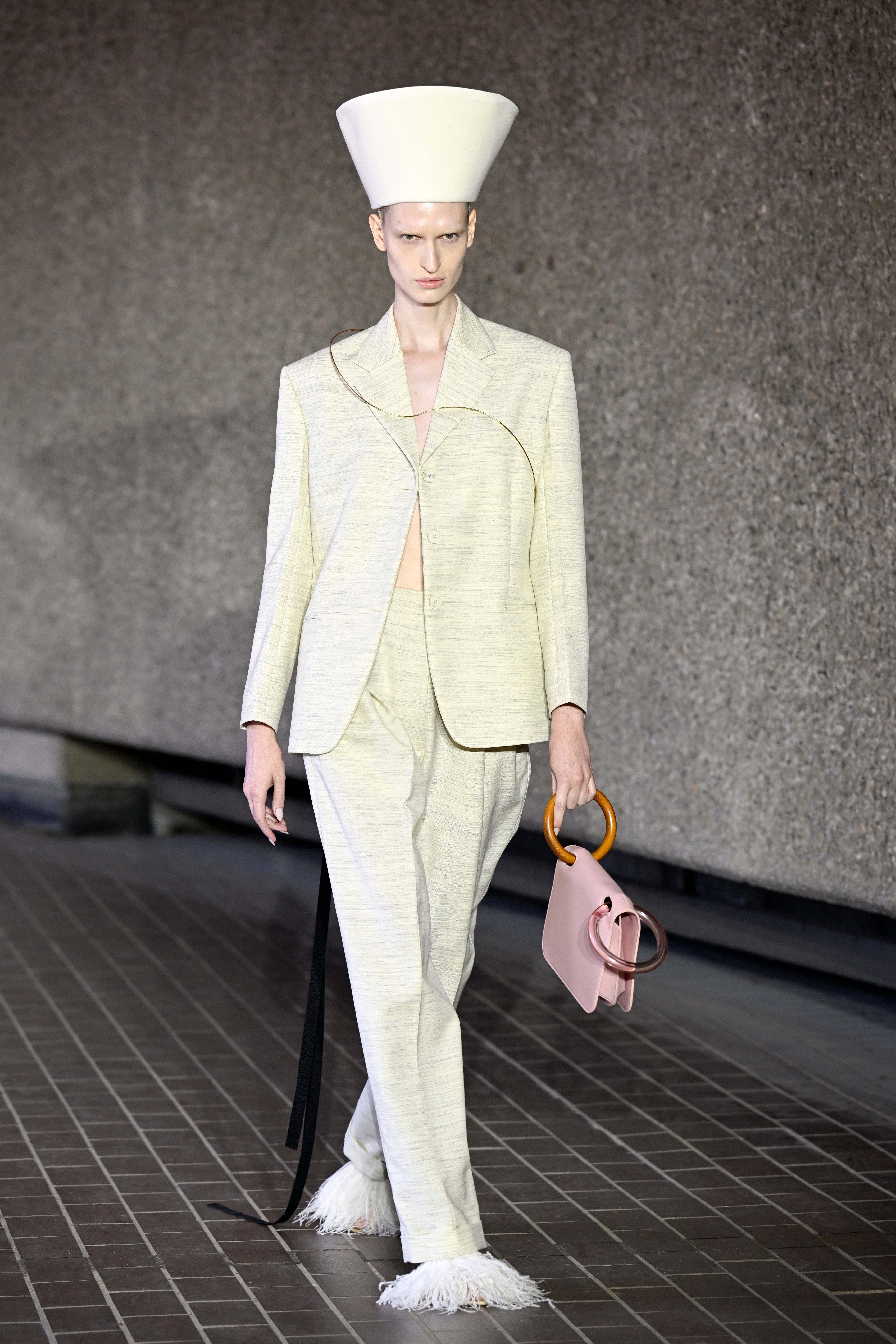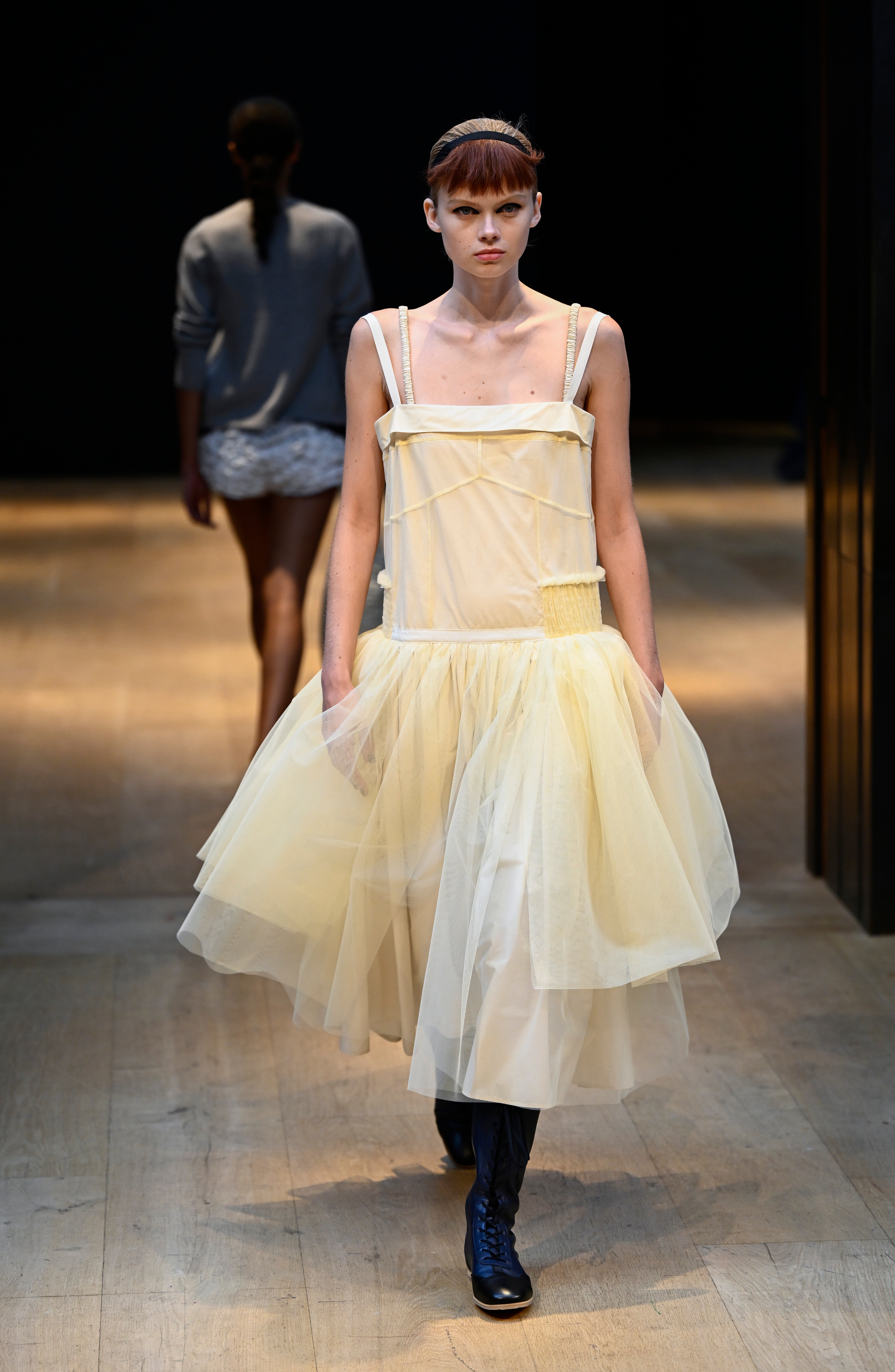From Harris Reed’s tuxedo-gown hybrids to Roksanda’s calash bonnets: London Fashion Week has never looked so weird
London ignores New York’s love of stealth wealth in favour of some truly outlandish designs, writes Joseph Bobowicz

Hot on the heels of a notably muted New York Fashion Week, London bucked the trend for stealth wealth reduction, opting instead for drama, bizarro twists and a heightened sense of independence.
Granted, London has always been ground zero for Planet Mode’s oddest oddities, but this season, held in relief against the monochrome palettes and “wearable” (read: commercial) offerings of the Big Apple, the Big Smoke felt like a haven for designers unwilling to loosen integrity or their strict codes. The fil rouge, in many senses, was the rejection of just that, leaning into queer couture, AI-designed collections, and a studied dissection of biography and heritage.
Toasting the procession on Wednesday night, Harris Reed was a case in point, serving up larger-than-life eveningwear that took a scalpel to gender binaries with calculated pairings. Upcycled black velvet formed tuxedo-dress hybrids, complete with ballooning trains held in position as if flying up à la Marilyn Monroe. Lapels were stiffened into dress hems, while make-believe hips akin to Christian Dior’s mid-century bar jacket enveloped pencil skirts, themselves dropped exactly to floor level.
Uncanny, but as chic as a Steven Meisel image, they’ll undoubtedly be gracing the tapis rouge soon, where Reed has already built a name for himself, often covering his show costs with custom sales. It might not read as immediately commercial, but as we’re learning, there’s a serious market for couture, and indeed, what Reed dubs “demi-couture”.
Over at Bora Aksu, held in the cloistered, manicured gardens of Goodenough College, the demi-couture theme continued, luring a well-heeled crowd that cannot get enough of Aksu’s Bo Peep confectionery and saccharine kawaii. This season, though, instead of nods to European aristocrats or the work of artists Henry Darger and Edvard Munch, Aksu took a personal turn. He mined his Turkish background for new designs, and riffed on the blankets his grandmother would weave and the dresses his mother made.
“I just wanted to go back to my roots,” he said. “Actually, my mother sent me some of the blanket squares used in the collection.” Fez hats, inspired by Ottoman dress, came in lace and crochet, while tufted skirts in baby pinks and daffodil yellow came replete with pearled butterfly embellishments and impossibly intricate broderie anglaise.
It was cute, but the bite of last season’s gothier outing was still felt in the black and white Victoriana and bows. In the Frows, you could immediately see the kind of woman wearing this, at once dainty and fragile but completely assured in herself, proudly feminine.

In perhaps the biggest curveball so far, Edward Crutchley delivered a sexed-up bonanza of latex gowns and plushy bags (and shoes!) alongside monochrome prints harlequinned together using an AI prompt. “I’ve been using AI for research images, so I find it really fascinating,” he explained. Looking at the brief he fed it, which included notes as sporadic as “medieval people on a fashion photoshoot”, “oversized tracksuit”, “liripipe hats” and “two gay men (in the style of Vermeer)”, it all makes sense. While a lot of people are fretting over creativity’s demise in the light of AI, the metaverse and ChatGPT, Crutchley is diving head-first into the danger zone.
Mark Fast is upping the clubwear ante, injecting heavy acid-wash denims, shredded and cut for combat
Similarly, Mark Fast has been keeping up to speed with a new world, continuing his expansion into designs for a younger, fresher customer. Now, having cemented his name for the open-stitch knits he’s been purveying from day dot, the Canadian designer is upping the clubwear ante, injecting heavy acid-wash denims, shredded and cut for combat – in the sense of dancing, not bar brawls, that is.
Meanwhile, his iconic macramé remained an eternal gesture, offset by trendier touches including the lapel-less suiting and panelled work shirts. Of course, though it’s now a familiar trope across runways, it’s gratifying to see the knitwear-as-lingerie method still working for him, especially as he pioneered it long before anyone had even considered a bodycon in dangerously loose looms.
At Fashion East, the talent incubation programme organised by fashion wunderkind Lulu Kennedy, the theme of doing it on your own terms was especially prevalent. Fortunately, dear reader, your correspondent walked in the show itself, wearing Olly Shinder, the rising CSM alum whose fetishistic obsession with workwear – and indeed its construction and complexity – has won over cult store Dover Street Market. This season, his German heritage and interest in the queer adaptation of otherwise heterosexual clothing took centre stage, bringing a tradesman uniform to life with meandering zips, sheer sweats, and a playful gingham, all merged into some notably Bavarian touches. As for the yellow T-shirt that read “Buddelkiste” – or “sandpit” in English – this referenced a particularly muddy fetish popular in North Germany.

The Fashion East roster this season also included Standing Geround, whose forte for “dump him” gowns has taken the industry by storm. Sure, you might call these minimal, at least from a glance, but look closely and those stiffened bands across the waist, tentacular pleats and vine-like tendrils that wrap lapels and waistlines alike speak for themselves. Then followed Joanna Parv, a designer bringing the otherwise male-dominated world of techwear to the ladies, streamlining the shapes for a svelte, sweat-wicking take on womenswear. Whether that’s the exquisite placement of an invisible zip across the décolletage or the toggled, wraparound skirts teamed with baby-blue cycle tops, her pieces would carry from gym to club.
Joanna Parv is a designer bringing the otherwise male-dominated world of techwear to the ladies, streamlining shapes for a svelte, sweat-wicking take on womenswear
Where Parv’s pieces might not fly, however, is the British Library, a place where one is expected to remove buckled rucksacks and coats so as to protect the historic scriptures available therein. Fortunately, this was not a concern for Ahluwalia, Priya Ahluwalia’s namesake label, which opened its show with model du jour Adwoa Aboah in a scarlet two-piece complete with leather gloves and boots.
This season, Ahluwalia mined the library, continuing a research process that deepens and formalises Africa’s history rather than singularising it into a homogenous continent. As such, the Algerian artist Baya Mahieddine, the muse of the mid-century, served as major inspiration. Here, nods to her surrealist designs – at the time reduced to “primitive art” – were merged into crisp shirting, while cowboy boots took on rich pink and green palettes alongside the designer’s now famous piped tracksuits and vintage Nigerian football kit riffs. Rapper Ghetts and broadcaster and presenter Clara Amfo were here for it, and so were the swathes of fash-packers in attendance. Kudos.
OK, we lied. There will be some minimalism at London, albeit with an artistic touch. Take, for example, Eudon Choi, whose effortless tailoring featured cut-out armholes and non-functional sleeves that functioned instead as an elegant draping device. Lapel-less blazer-short combos or doubled-up blazers and culotted trews in pastel were the icing on the cake. Choi’s starting point? “We wanted to play around this time with the impressionist Berthe Morisot,” he explained. Morisot had a unique approach to depicting womanhood – on its own terms – and this was felt in the collection’s soft and airy ease. Developing on the previous resort collection, which channelled artist Edward Hopper’s ingenious use of light, this was all about femininity left to flourish.

Speaking of femininity, Roksanda has always done this her way – bold and beautiful. Naturally, Roksanda served just that. One expects a capital-S show from the Serbian maven, and indeed, that ensued from inside the Barbican sculpture park. Sat beneath London’s favourite middle-class estate, the crowd were serenaded in the sweltering heat by an opera maiden. The ever-iconic Anna Wintour graced us with her presence, greeting actor Dame Vanessa Redgrave on arrival. If that sounds glamorous, you better believe the looks matched the occasion. We’re talking calash bonnets in marl wool tailoring, and delicious charges of colour that we know and love Roksanda for.
As the dresses – boned in offbeat positions to create modern farthingales and crinolines – wobbled past, further details revealed themselves. Inside a layer of pink acrylic, fluttering ostrich feathers were caged like rare curios. In practice, it channelled the right level of commercial nous to entice the ladies that lunch – who, no doubt, bankroll the brand – and of course the wilder fashionheads, who can’t resist a lilac ball gown replete with cardboard-esque ribbing and cascading, sculptural lines. Chic, but a little bit freak.
And yes, even the London stalwart Molly Goddard has been switching up her approach these past few years. Where once she was known as the ultimate in west London party-girl dressing, now, well into her stride, she’s honing and developing the label beyond the tulle balls she’s synonymous with.

This time round, she’s bringing a wider toolkit, applying her frills to schoolgirl uniform dresses and tailoring alike. A welcome addition of tartan denim arrived in acidic yellows and greens, peaking just below the frou. On feet, a set of Seventies boxer boots, arriving also as pumps in gold and silver. The dresses, tiered into duvet sections, felt especially on trend, and yet still in keeping with the tenacious Taylor teen.
Perhaps most embodying this London sense of integrity was Sinead O’Dywer’s show-cum-workshop, in which i-D editor Mahoro Seward interviewed the designer in real time as models floated past. “I’m trying to do less styles and less seasons, and influence buyers to buy more sizes of just one style,” explained O’Dwyer.
During the show, models donned cross-knitted bodysuits, which clung and caressed bodies no matter their shape. O’Dwyer picked out the specific ways shirt pleats or even gabardine trench coats are cut depending on the model. It was about accommodating – or better yet, celebrating – shapes that aren’t size zero. Bookending the shows, it made for a poignant and thoughtful moment, speaking to everything London prides itself on: daring art schools, bold designers, and an approach that’s willing to break the mould. This was about selling a vision without selling out.






Join our commenting forum
Join thought-provoking conversations, follow other Independent readers and see their replies
Comments